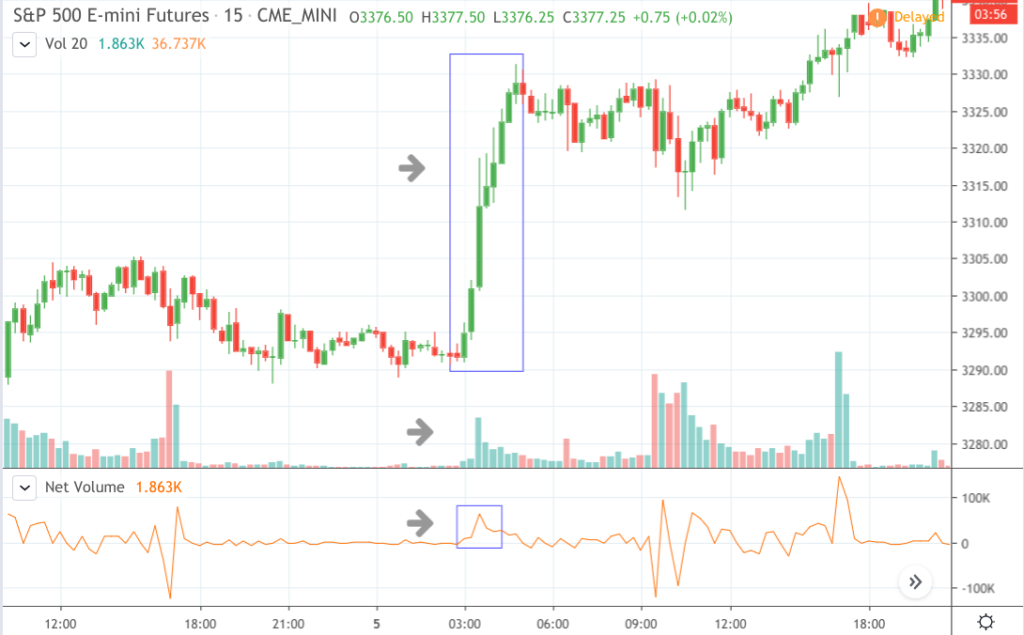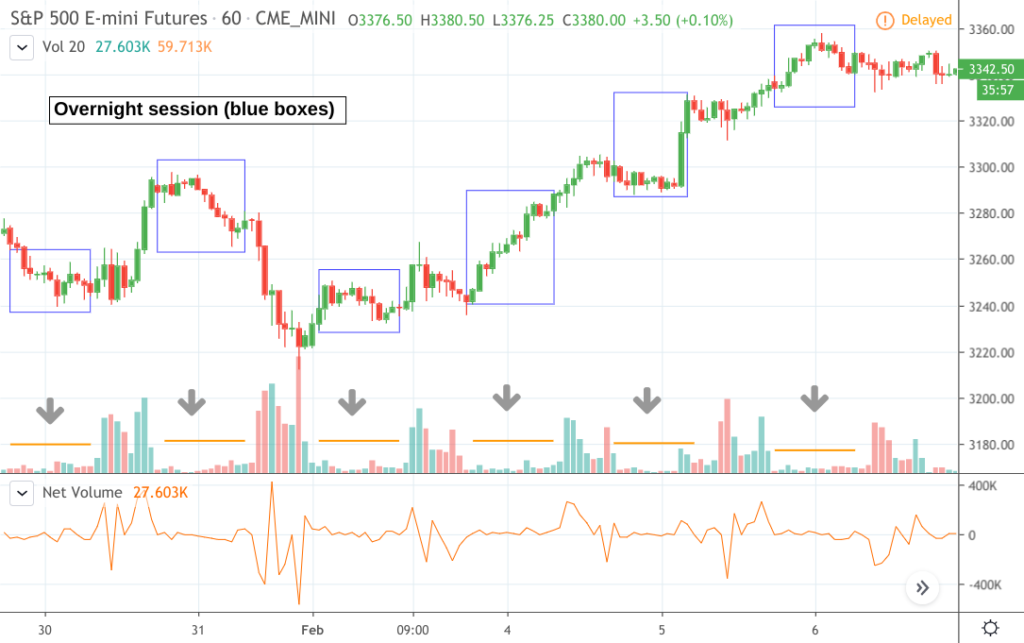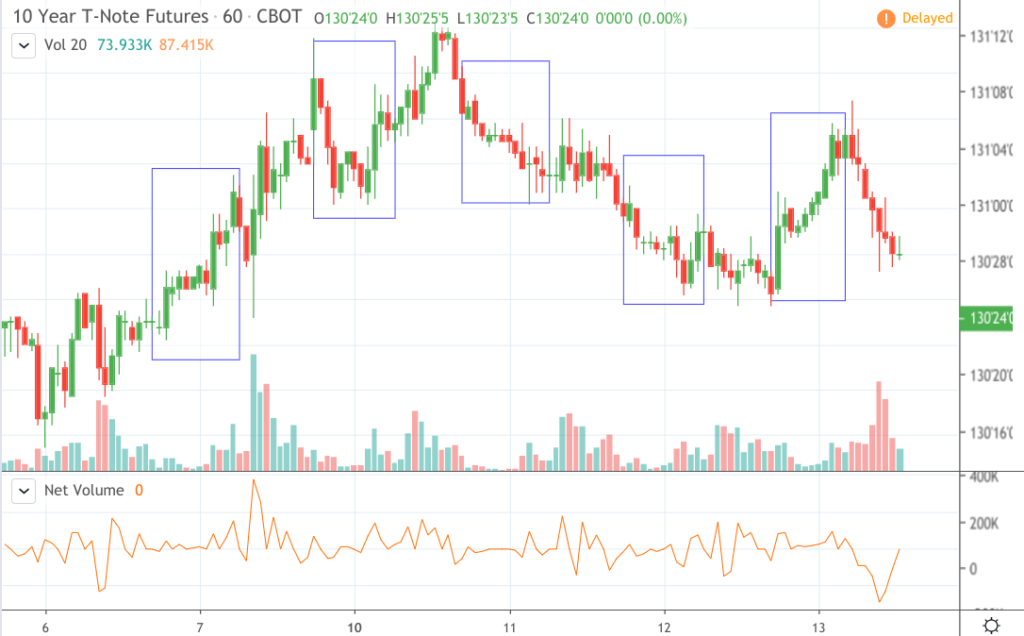If you’re a short-term trader, you’ve likely woken up early in the morning ready to trade the markets only to realize that the big move had already happened overnight. This may leave you with very little to do, save waiting for a pullback or perhaps a continuation (or reversal) of the overnight move.
Aside from this, however, you’ve probably been seeing overnight volume for US indexes picking up overnight, however slightly. Arguably, this may be due to the rest of the world responding to US-China trade war fears, coronavirus fears, and maybe even the supposed “repo” market (overnight lending) liquidity crisis.
So, maybe trading the “overnight” session isn’t a bad idea. Well, it’s neither a bad nor good prospect, just one that either fits your trading style (and trading hours) or doesn’t. Before you jump in to trade the ES, YM, or NQ at 2am somewhere in the continental US, consider these four things.
1 – Are the Markets Liquid Enough for Your Trading Strategy?
Take a look at this move on the ES on February 5 starting at 3:00 am ET.

ES 15-Minute Chart – February 4 to 5, 2020
It was a huge move. But the thing to notice (looking at the arrows pointing to volume and the net volume indicator), is that the volume was still half of that you’d encounter during regular NYSE hours. Volume peaked at 63.82k whereas the regular trading session later that day peaked at 120.10k.
Let’s take a look at the overnight sessions in the ES from January 29, 2019 to February 6, 2020.

ES 1-Hour Chart – January 29, 2019 to February 6, 2020
Note that the overnight volume, despite picking up here and there likely in response to global events, is still relatively low. But this doesn’t necessarily mean that you should or shouldn’t trade it.
The Takeaway: If you’re going to trade the overnight session, then you might want to consider whether the liquidity levels are adequate for your strategy. For instance, a swing trader who’s looking for a one- or two-day move (or longer) might not have a problem with getting into or out of a given contract. But a day trader who’s looking to scalp one- to two-points several times during the session may still experience price slippage due to the lack in volume. Of course, the only way to find out is to trade the overnight session.
2 – Is Your Instrument of Choice Suitable for Overnight Trading?
Many short-term traders in the US stick to the three major indexes, but there are other instruments to consider as well.
Grains: For instance, if you trade wheat or soybeans, you’d have to have a strong reason why you might want to trade any of them overnight. Between the two, soybeans might see more action depending on the trade environment with China (as it is one of the largest, if not the largest, buyer of US soybeans).
US 10-Year Treasury Notes (ZN): This instrument also tend to move a lot during the overnight session.

ZN – 1-Hour Chart – February 5 to 13, 2020
Although not the most “popular” day trading instrument for many retail traders, the ZN is actually one of the most liquidly-traded instrument among all CME instruments, as financial institutions across the world are almost always responding to moves in the US debt market.
The Takeaway: If you’re looking to trade a particular instrument overnight, be sure that there’s a fundamental reason why a given market will move. Ask yourself, who across the globe might be trading this during the overnight hours; why might they trade it; is there something happening economically or geopolitically that might affect the instrument I’m trading?
3 – What Fundamental Factors Might Affect the Overnight Session?
With coronavirus fears growing, there’s every reason to expect movement in China’s Hang Seng Index and those of other indexes (such as the ES, YM, and NQ) that may be affected. When the US-Iran crisis flared in January, there was a strong reason to believe that crude oil was going to be active overnight. Throughout the last few years, rhetoric on soybean tariffs gave traders a reason to trade soybean contracts overnight
The Takeaway: Markets may move on technical price action, but if you’re trading the overnight session, where liquidity in the US dries up a bit, you’d better have a strong fundamental reason to do so.
4 – Who is Trading and When?
The best time to trade is almost always when everyone else is trading. It’s easier to find other sellers to buy from, or other buyers to sell to. So, if you’re planning to engage other traders who may be trading across the globe, then it helps to know when most of them are trading.
Here’s a quick list of trading hours across the globe in GMT:
- Asian Session: 11:00 pm to 8:00 am GMT
- European Session: 7:00 am to 4:00 pm GMT
- US Session: 12:00 pm to 8:00 pm GMT
Depending on where you are in the globe, you’ll have to convert GMT to your local time to get an accurate and localized picture of the entire schedule.
The Bottom Line
Trading the overnight session might provide some traders an extra opportunity to engage certain markets. It isn’t for everyone, and the lack of liquidity may pose some risk. But if the liquidity suits your trading approach, if the instrument correlates with global interest among financial traders, if there are fundamental reasons to trade a given instrument during the off-hours, and if you’re aware of the international trading hours, then the overnight session just might provide you with market opportunities that you may not find during your location’s regular hours.
Please be aware that the content of this blog is based upon the opinions and research of GFF Brokers and its staff and should not be treated as trade recommendations. There is a substantial risk of loss in trading futures, options and forex. Past performance is not necessarily indicative of future results.
HYPOTHETICAL PERFORMANCE RESULTS HAVE MANY INHERENT LIMITATIONS, SOME OF WHICH ARE DESCRIBED BELOW. NO REPRESENTATION IS BEING MADE THAT ANY ACCOUNT WILL OR IS LIKELY TO ACHIEVE PROFITS OR LOSSES SIMILAR TO THOSE SHOWN. IN FACT, THERE ARE FREQUENTLY SHARP DIFFERENCES BETWEEN HYPOTHETICAL PERFORMANCE RESULTS AND THE ACTUAL RESULTS SUBSEQUENTLY ACHIEVED BY ANY PARTICULAR TRADING PROGRAM.
ONE OF THE LIMITATIONS OF HYPOTHETICAL PERFORMANCE RESULTS IS THAT THEY ARE GENERALLY PREPARED WITH THE BENEFIT OF HINDSIGHT. IN ADDITION, HYPOTHETICAL TRADING DOES NOT INVOLVE FINANCIAL RISK, AND NO HYPOTHETICAL TRADING RECORD CAN COMPLETELY ACCOUNT FOR THE IMPACT OF FINANCIAL RISK IN ACTUAL TRADING. FOR EXAMPLE, THE ABILITY TO WITHSTAND LOSSES OR TO ADHERE TO A PARTICULAR TRADING PROGRAM IN SPITE OF TRADING LOSSES ARE MATERIAL POINTS WHICH CAN ALSO ADVERSELY AFFECT ACTUAL TRADING RESULTS. THERE ARE NUMEROUS OTHER FACTORS RELATED TO THE MARKETS IN GENERAL OR TO THE IMPLEMENTATION OF ANY SPECIFIC TRADING PROGRAM WHICH CANNOT BE FULLY ACCOUNTED FOR IN THE PREPARATION OF HYPOTHETICAL PERFORMANCE RESULTS AND ALL OF WHICH CAN ADVERSELY AFFECT ACTUAL TRADING RESULTS.